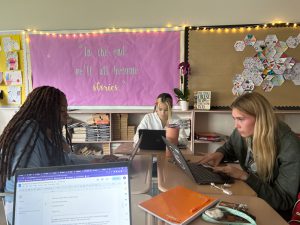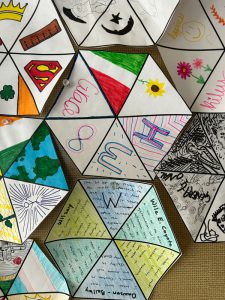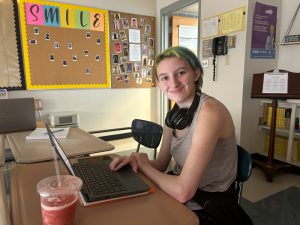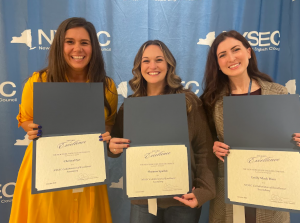 Shannon Spollen’s Create Writing classes give junior and senior class members a supportive yet challenging way to get comfortable with writing. The class, which the VCSD English Department recently reintroduced as a half-credit elective, is taking students from fairy tales to AI, all while preparing them for college and careers.
Shannon Spollen’s Create Writing classes give junior and senior class members a supportive yet challenging way to get comfortable with writing. The class, which the VCSD English Department recently reintroduced as a half-credit elective, is taking students from fairy tales to AI, all while preparing them for college and careers.
Spollen says many students enter the class not seeing themselves as writers, a perception that is her priority to dispel. She provides multiple approaches to writing, with assignments involving everything from formal essays to private writing, some of which students add to a portfolio to share with friends, family or college admissions personnel.
One assignment involves writing fractured fairy tales, when students experiment with changing a setting, characters, and endings to develop new versions of classic stories. Throughout the assignment, students analyze aspects of stories like point of view, characterization, building worlds, and creating dialogue while determining what aspects work and don’t work.
Critical thinking is cultivated in the class, and Spollen pushes the students to enlarge their worldview by reading contemporary literature. She seeks out local authors who are not much older than her students to help inspire them.
 “I want them to think critically about the things that they read and the things that they write,” said Spollen. “I don’t ever want them to take information at face value. Where is it coming from? Are there any biases here? What if it was told from a different point of view?”
“I want them to think critically about the things that they read and the things that they write,” said Spollen. “I don’t ever want them to take information at face value. Where is it coming from? Are there any biases here? What if it was told from a different point of view?”
With artificial intelligence (AI) making an unprecedented mark on writing, academic institutions are forced to examine how the technology impacts learning. Spollen says she doesn’t want students to be punished for using this modern tool, so she is developing methods to explore this new territory.
One method is to have AI write an example of a short story and have students critique it. Another involves work on essays. Spollen points out that AI may be able to generate a foundation for an essay, but the technology can’t replicate how students communicate about their human experiences. She gives an example of an AI essay on playing soccer.
“You need to add the details about how you remember your first soccer game when mom showed up at the age of three, and you scored that goal, and you went to McDonald’s and got an ice cream cone,” she tells students. “You need to integrate what the weather was like; the sweat was pouring down your neck.”
Creative writing provides students with a cathartic outlet that differs from the academic writing style they have been taught.
“From kindergarten to now, the students haven’t ever wanted to be wrong in their assignments,” Spollen said. “In creative writing, there is no right or wrong; there is only try. It’s part of being human. For example, you can’t always say exactly what you feel to the people you’re feeling it towards, but you can write it down. And then you can throw it out, and you’ll be surprised at how much lighter you feel when you do that.”
Senior Kaili Waldron credits Ms. Spollen with improving her writing skills: “Building character in my writing, adding emotions.”
 For junior Jack Parker, the Creative Writing class has offered some surprises.
For junior Jack Parker, the Creative Writing class has offered some surprises.
“I knew I wanted to take the Public Speaking class because I want to improve in that, and I thought Creative Writing would be a good compliment to that,” said Parker. “I was surprised by all the art in the class. We talked about and wrote horror stories, but we also made illustrations. I like that the class encompasses a lot of different elements.”

Spollen’s dedication to helping students express themselves extends beyond the classroom.
Every summer, she collaborates with other teachers to provide the “Discovering Your Voice” writing course in conjunction with the Capital District Writing Project and The NYS Writers Institute through SUNY Albany for students grades 10-12.
